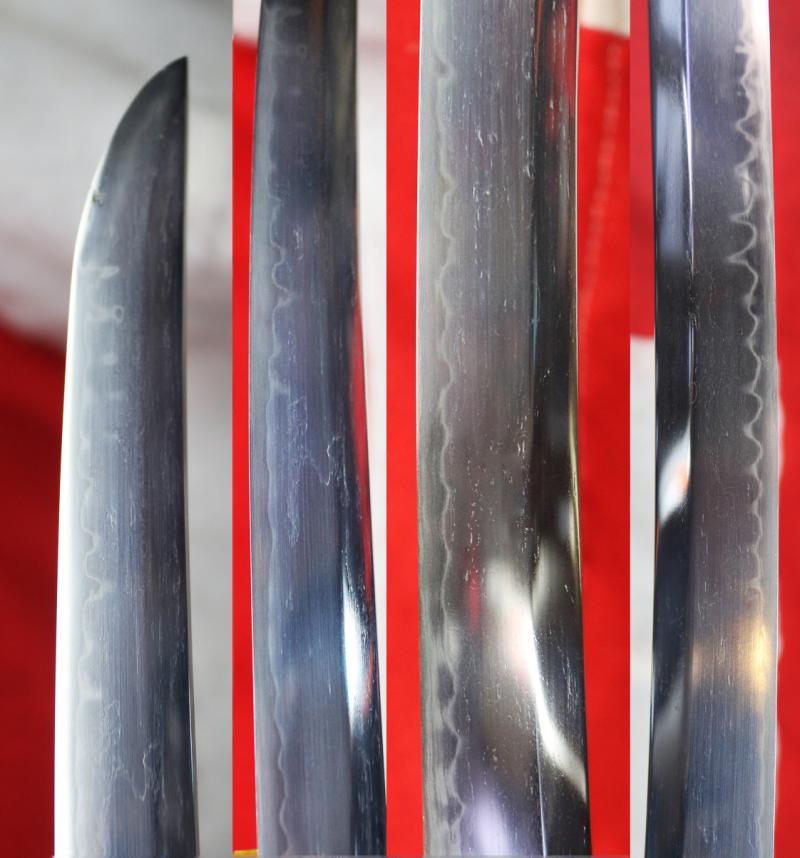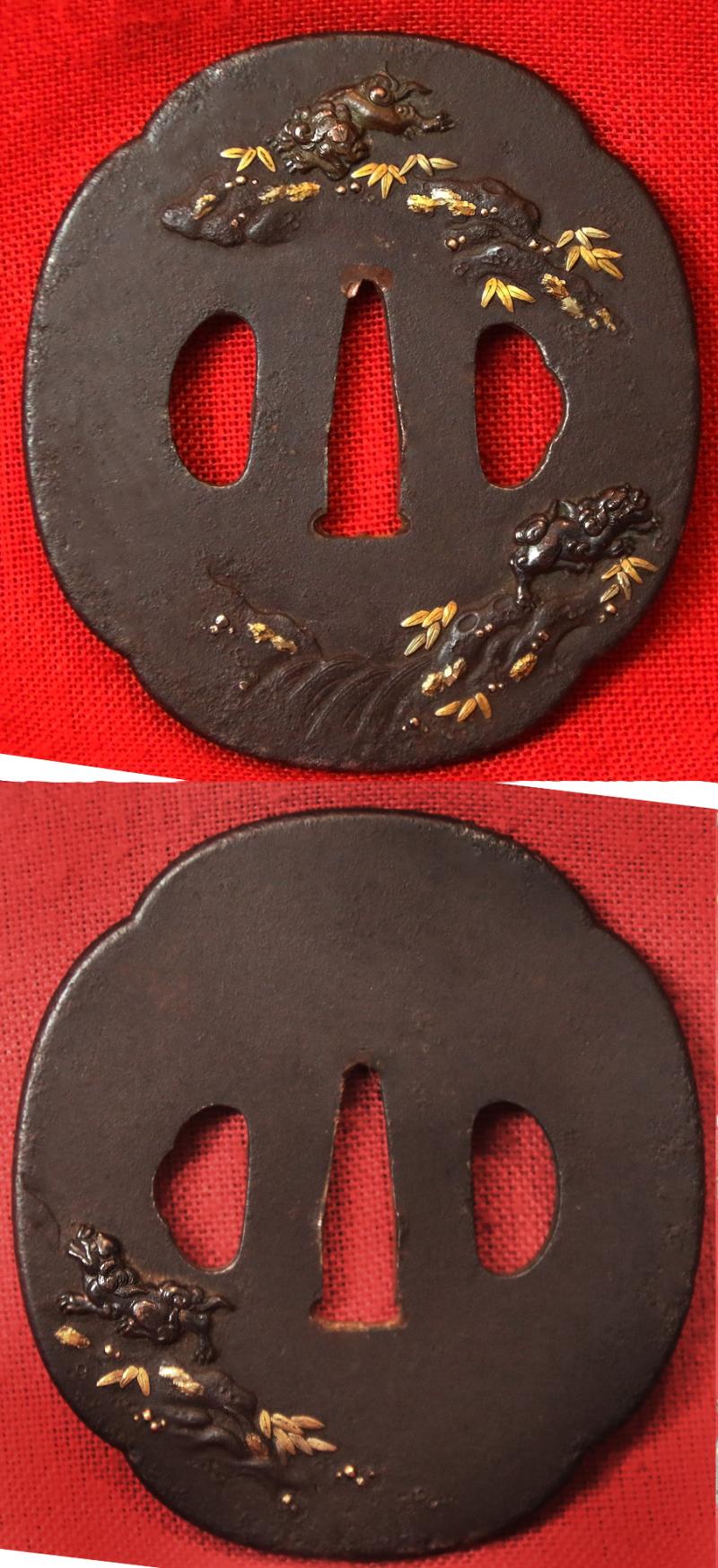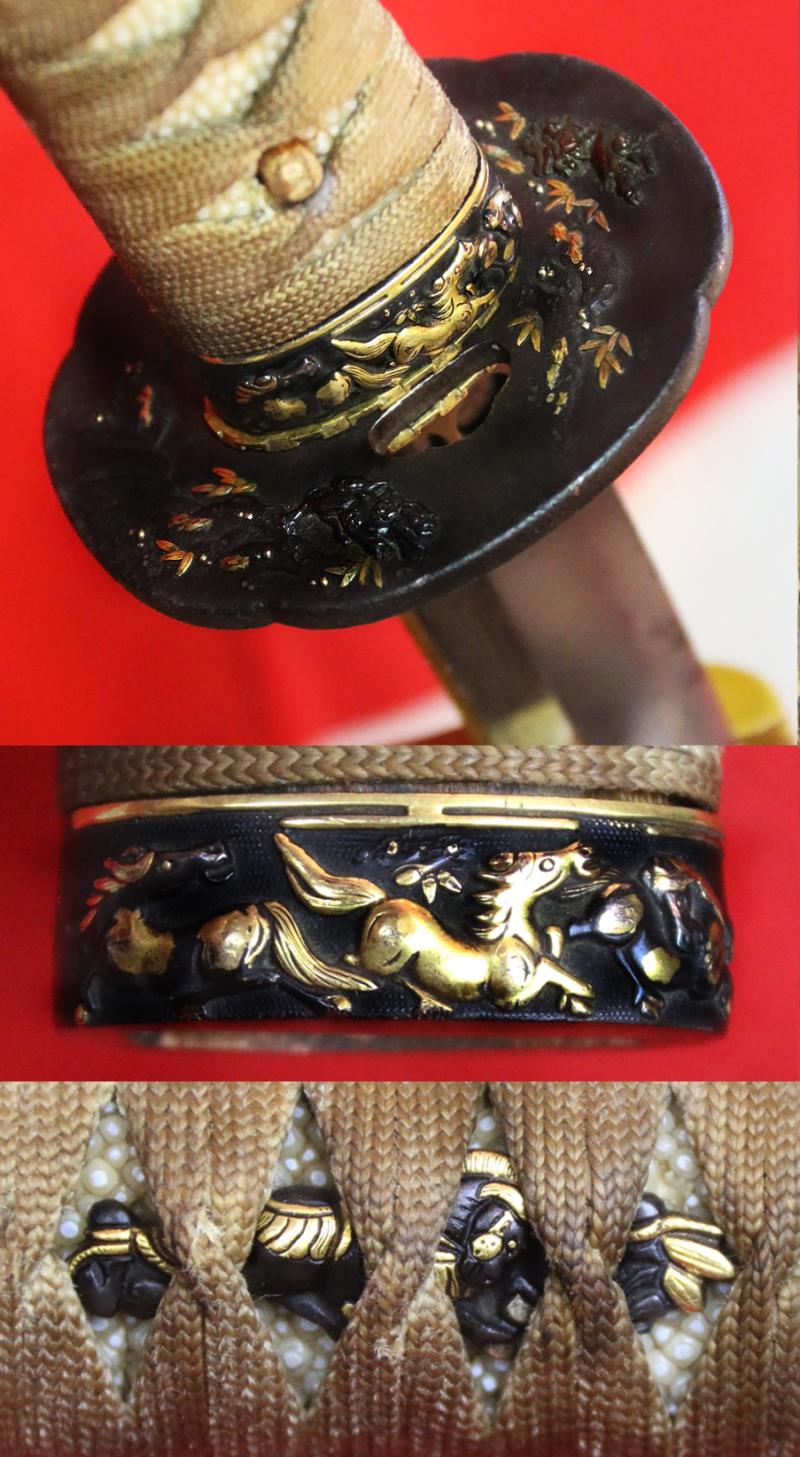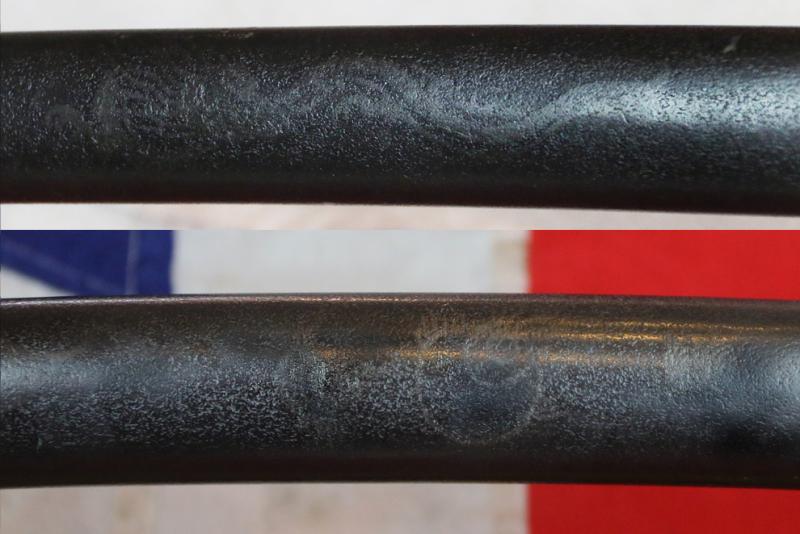A Breathtaking Ancient Daimyo Quality Samurai Katana Up To 700 Years Old, of the Matsura Clan With All Original Edo Mounts of Finest Goto School Quality Made of Pure Gold and Shakudo
A Matsura clan sword, {also spelt Matsuura}, especially of such rank and quality, is a very rare thing, but to get two high ranking swords from two members of the same family, is an amazingly rare occurrence, especially as they were used by the Matsura many hundreds of years apart, and sourced from two entirely unconnected private collectors. See 24983 for the WW2 Matsura Generals sword
A stunningly impressive sword and the blade looks absolutely fabulous. The fuchi of Goto school is one of the most beautiful we have seen, of prancing pure silver and shakudo samurai ponies, over a nanako ground, under the ito are Goto, shakudo and pure gold ponies, adorned in gold samurai armour, and the Goto tsuba is decorated with pure gold and shakudo shi shi lion dogs, on a mokko shaped iron plate. The kashira is carved black buffalo horn, the tsuka hilt is bound in original Edo period Imperial 'shiro' white silk tsuka-ito, the colour of purity, and with the combination of superior Goto fittings it is indeed indicative of the mark of the highest rank and status of samurai, possibly even of daimyo rank.
Nanako Ji: "fish roe ground" A surface decoration produced by forming very small raised bosses by a sharply struck punch or burin called 'nanako tagane'. Shakudo is the metal most often used, but copper and gold are quite often employed. The harder metals, shibuichi, silver and iron are rarely decorated in this way. The size of the dots vary from 0.04" to 0.008" (25 to 125 and inch) and the regularity of the work is marvelous as the dots must be spaced entirely by touch. The dots are usually arranged in straight lines or in lines parallel to the edge of the piece being decorated, but sometimes in more elaborate patterns. Used on guards since the Momoyama period although the technique existed since much earlier periods. Usually done by specialist 'nanako-shi', but sometimes done by the maker of the guard himself.
The colour white was called 'shiro, the colour of the gods'. White was also the colour that a samurai who was to commit seppuku should wear. The Imperial white ito has now aged to a mellow off-white.
The blade is likely from between the Kamakura 1192-1336 to Nambokochu 1333 to 1391 period and has an astoundingly deep curvature typical of the ancient period of sword making of 700 years ago. It is showing a beautiful gunome hamon with stunning activity, and in super condition for age.
This is the perfect example to show just how incredible early samurai sword blades are, appearing much as it did around 700 years ago, due its quality and the care and respect it received over the past hundreds of years. By comparison, there is likely not a single surviving European sword blade of the same age, in the same condition, anywhere in the world.
The original Edo period ishime stone finish urushi lacquer saya has a amazing hidden dragon within the lacquer finish itself , that can only seen when the saya is rotated slightly to hit the light just so. The habaki has the three pierced circle clan kamon of the Matsura clan.
As the military class (buke, or samurai) increased in numbers and importance during the 11th and 12th centuries, the term daimyo came to be applied to those military lords who began exercising territorial control (and later proprietary rights) over the various private estates into which the country had become divided. In the 14th and 15th centuries the so-called shugo daimyo arose. These daimyo were appointed as military governors (shugo) under the Ashikaga shoguns (hereditary military dictators), and they held legal jurisdiction over areas as large as provinces. The shugo daimyo’s private landholdings were quite limited, however, and these daimyo gained much of their income from levying taxes on the cultivated lands owned by civil aristocrats and religious establishments. In the second half of the 15th century the shugo daimyo were supplanted by the Sengoku daimyo (i.e., daimyo of the Sengoku, or “Warring States” period); these military lords held small but consolidated domains in which all the land belonged to themselves or was held in fief by their vassals. By the late 15th century the Sengoku daimyo had divided Japan into a series of small, belligerent states as each individual daimyo competed for the control of more territory. The Sengoku daimyo built castles in the hill country from which they controlled their vassals, who likewise were petty landowners with castles.
In the 16th century the Sengoku daimyo fought among themselves constantly, and a process of consolidation ensued, with fewer and fewer daimyo emerging from the local wars and each holding more and more territory. In 1568 Oda Nobunaga began the movement of decisive military conquest over the daimyo that was later carried on by Toyotomi Hideyoshi and completed in 1603 by Tokugawa Ieyasu. By this time roughly 200 daimyo had been brought under the hegemony of the Tokugawa family, the head of which served as shogun.
The Gotō School of sword-fittings makers was founded in the fifteenth century by Gotō Yūjō, who is said to have been patronized by the shogun Ashikaga Yoshimasa (1435–1490). The work of the Gotō masters is characterized by painterly designs carved in high relief on a ground of shakudō (an alloy of copper and gold chemically treated to turn a rich blue-black), finished in nanako (tiny circles punched regularly over the surface to give it a granular appearance) with colorful accents in gold and silver. The succeeding generations of Gotō masters continued to work in these soft metals and concentrated on the smaller sword fittings, such as kozuka (the handle of the small utility knife fitted into a slot on the back of a sword scabbard), kōgai (a skewer-like hairdressing tool carried in the front of the scabbard), and menuki (a pair of grip ornaments secured by the handle wrappings).
The Matsura family of Hirado, in present-day Nagasaki Prefecture, has a long and storied 800-year history. The clan’s origins are quite colourful—they were involved in trading with Korea and China, smuggling and even piracy. During the epic war between the Taira (Heike) and Minamoto (Genji) at the end of the Heian period, the Matsura sided with the Heike and provided men and boats for the climactic battle of Dannoura, which ended in a complete victory for the Minamoto and paved the way for their leader, Yoritomo, to establish the Kamakura Shogunate, beginning the era of warrior rule of Japan.
During the Kamakura period, the Matsura, through there trading and smuggling network along the vital Chinese ports and trade paths, helped keep the Shogunate informed of Kublai Khan’s invasion plans for Japan in 1274 and 1281 and once again supplied men and material to fight the Mongol invaders. Later on, in the 1500s, as Japan fell deeper into the chaos of civil war, the Matsura gradually increased their powerbase and became a hub of international trade with the Portuguese, Dutch and English, amassing an incredible amount of wealth in this little corner of Kyushu.
The Matsura allied themselves with Toyotomi Hideyoshi when he invaded Kyushu as part of his campaign to unify Japan. In return for their loyalty, Hideyoshi confirmed Matsura Shigenobu as daimyo (feudal lord) over Hirado, a holding valued at an annual income of 63,200 koku (1 koku = amount of rice needed to feed one person for a year). This income was handsomely complimented the amount of money the Matsura were hauling in from legitimate foreign trade as well as the old smuggling and piracy connections (direct involvement in piracy seems to have faded by the early 1600s). As a loyal vassal to Hideyoshi, Shigenobu led a large contingent of his samurai into Korea as a part of Japan’s failed invasion of Korea from 1591-1598. Upon the end of the war, the Matsura built Hinotake Castle as the clan’s main residence. However, the extensiveness of the Castle’s defences, combined with the clan’s neutrality during the clash between the pro-Toyotomi and Tokugawa forces at the battle of Sekigahara brought the clan under the suspicion of the Tokugawa as they consolidated power under their new shogunate. Knowing the clan had much to lose in terms of trade grants as well as its fief, Shigenobu took the dramatic step of setting Hinotake Castle on fire to show the Tokugawa that he was defenceless and at their mercy as a loyal retainer. Blade tsuba to tip 28.25 inches long , 40 inches long overall , tsuka 10.75 inches long.
Code: 24321










